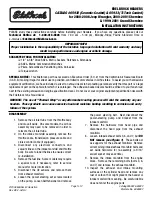
GMC Yukon/Yukon XL/Denali Owner Manual (GMNA-Localizing-U.S./
Canada/Mexico-16417394) - 2023 - CRC - 4/26/22
Vehicle Care
353
Replace the tire if:
.
The indicators at three or more
places around the tire can be seen.
.
There is cord or fabric showing
through the tire's rubber.
.
The tread or sidewall is cracked, cut,
or snagged deep enough to show
cord or fabric.
.
The tire has a bump, bulge, or split.
.
The tire has a puncture, cut, or other
damage that cannot be repaired well
because of the size or location of the
damage.
Tire Rotation
Tires should be rotated according to the
interval listed in the maintenance
schedule. See
Tires are rotated to achieve a more
uniform wear for all tires. The first
rotation is the most important.
Anytime unusual wear is noticed, rotate
the tires as soon as possible, check for
proper tire inflation pressure, and check
for damaged tires or wheels. If the
unusual wear continues after the
rotation, check the wheel alignment.
See
and
Use this rotation pattern when rotating
the tires.
Do not include the spare tire in the tire
rotation.
Adjust the front and rear tires to the
recommended inflation pressure on the
Tire and Loading Information label after
the tires have been rotated. See
and
.
Reset the Tire Pressure Monitor System.
See
Tire Pressure Monitor Operation
Check that all wheel nuts are properly
tightened. See
“
Wheel Nut Torque
”
under
and
“
Removing the Flat Tire and
Installing the Spare Tire
”
under
{
Warning
Rust or dirt on a wheel, or on the
parts to which it is fastened, can
cause wheel nuts to become loose
over time. The wheel could come off
and cause a crash. When changing a
wheel, remove any rust or dirt from
places where the wheel attaches to
the vehicle. In an emergency, a cloth
or paper towel can be used; however,
use a scraper or wire brush later to
remove all rust or dirt.
















































